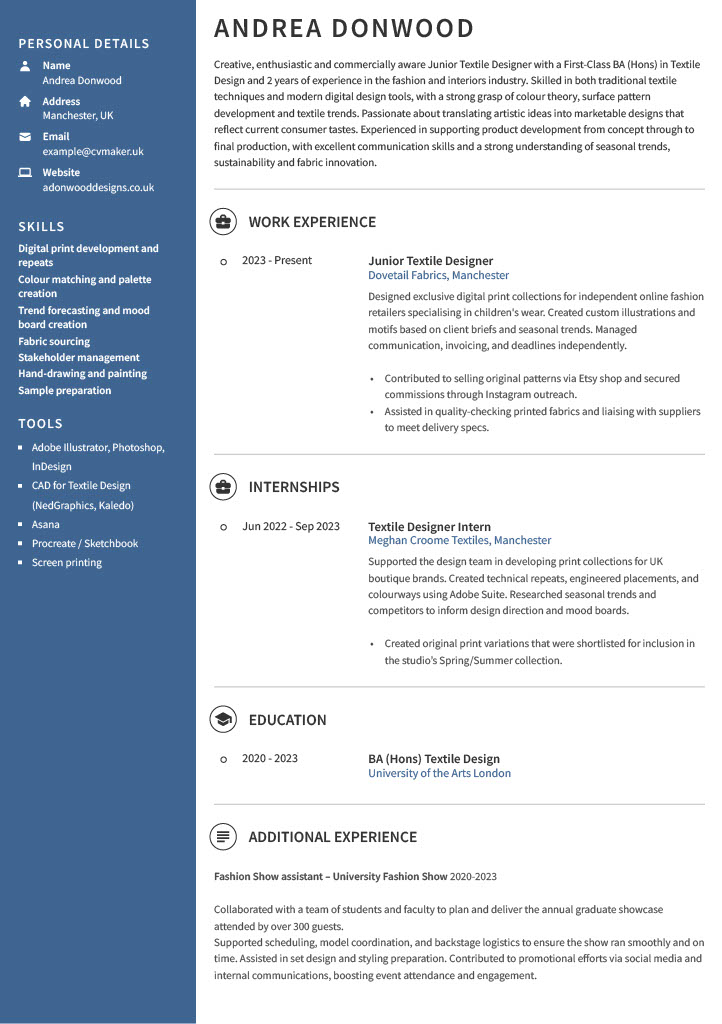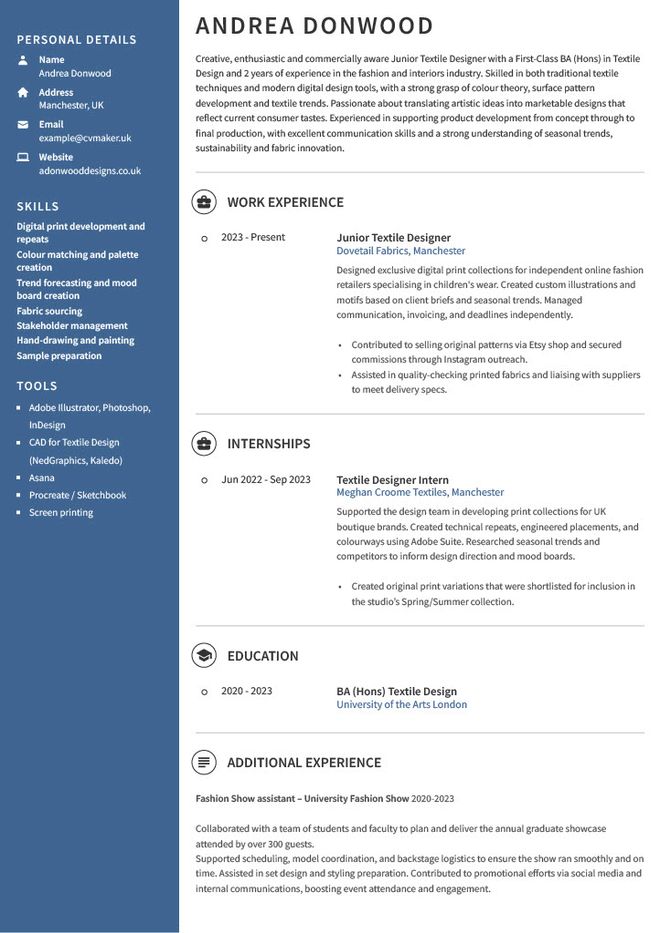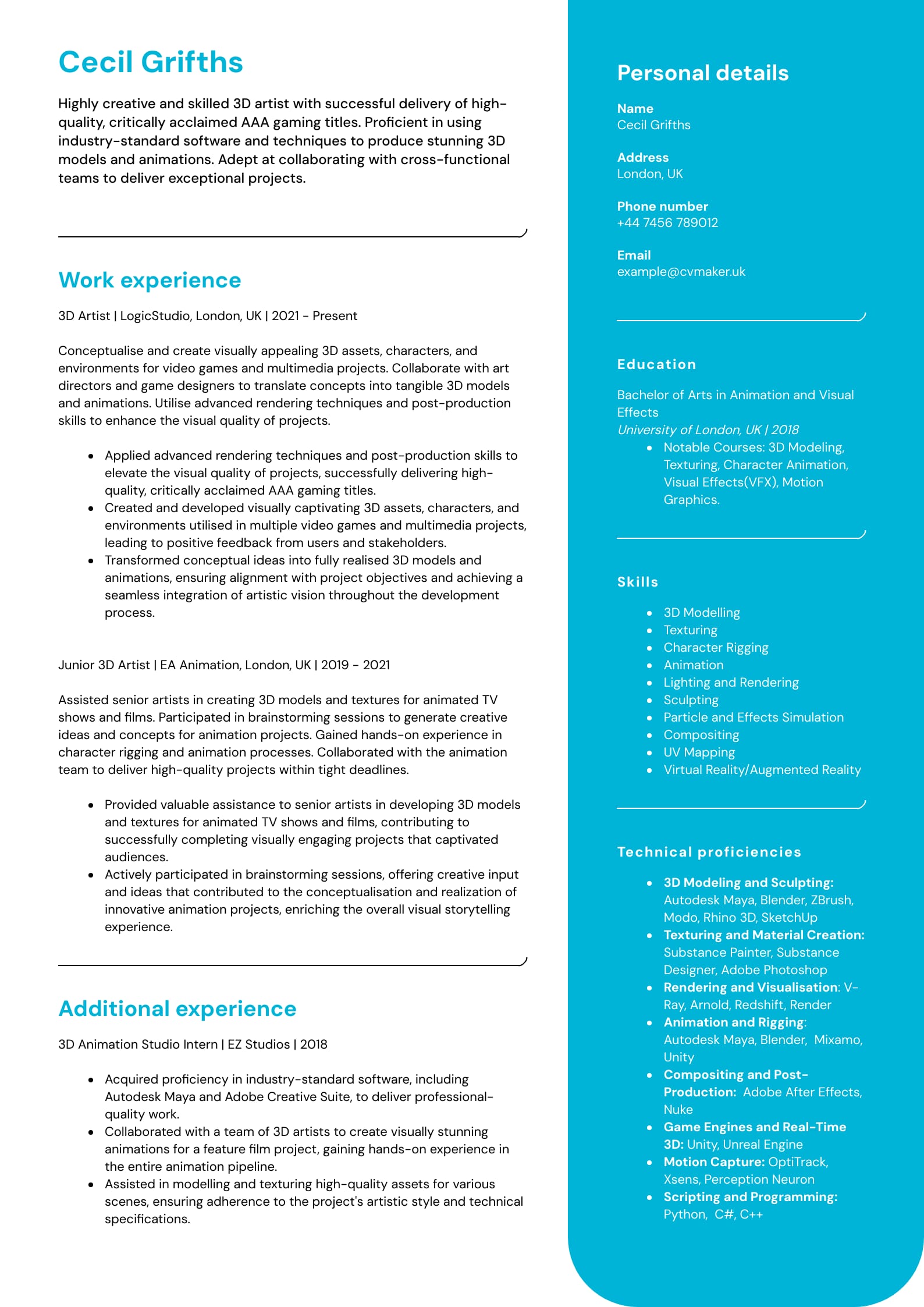
How to Write a CV for a Textile Designer: Showcase Your Creativity
From fashion and interiors to surface design, your CV can be the deciding factor in making a lasting impression on employers. In this guide, you will learn how to create a modern textile designer CV that balances creative flair with technical precision. We cover formatting strategies that work for design roles, along with practical tips to impress industry recruiters.
You will also discover what hiring managers expect, how to showcase your portfolio for maximum impact, and the most effective ways to highlight your design skills, trend knowledge, and achievements.
In this article, we cover:
Essential sections to include in your textile designer CV for maximum impact.
How to highlight technical expertise and design skills.
Showcasing your portfolio, achievements, and awards.
How to write a professional CV for a textile designer job to get shortlisted for an interview.
Formatting your CV with applicant tracking system (ATS)-friendly tips to ensure your application gets noticed.
Streamline your CV writing process with CVMaker, featuring intuitive designs and advice on how to choose the best CV template.
Customise this textile designer CV example
Textile designer CV example
 Download textile designer CV in PDF.
Download textile designer CV in PDF.
Andrea opted for the Harvard CV template to present her credentials with professionalism and clarity. This textile designer CV example includes key skills and a profile highlighting a strong academic background and two years of experience as a Junior Textile Designer, emphasising creativity, trend awareness, and technical proficiency.
What to include in a textile design CV?
Before you start writing, plan your CV using a clear, logical structure. A strong textile designer CV should include:
Contact information: personal details such as an email, phone number, and location.
Personal profile: short introduction highlighting your creative expertise and career goals.
Skills: a mix of hard and soft skills, such as Adobe Creative Suite, CAD tools, and collaboration with cross-functional teams.
Work experience: detailed descriptions of your previous roles, responsibilities, and measurable achievements.
Education: relevant qualifications, such as a Bachelor of Fine Arts or Arts in Textile Design.
Portfolio and achievements: links to your portfolio, awards, and notable projects.
Must-have CV sections
Personal profile
Skills section
Work experience
Education
Learn more about how to write a good CV.
Need help getting started? Check out our step-by-step master CV guide on how to build a strong foundation for your CV.
How to list textile designer skills in a CV?
Employers are looking for multi-skilled designers who can combine artistic flair with technical know-how and teamwork. Integrate hard and soft CV skills into your experience section and personal profile.
Your skills section should showcase both technical expertise and interpersonal strengths. Highlight your proficiency with design software and IT skills. List soft skills such as communication, teamwork with product teams, time management, and the ability to adapt to emerging trends.
Check out our guide on the top skills that employers look for further examples.
Essential textile designer skills (with definitions)
Textile pattern: ability to create repeat patterns for digital or manual printing.
Computer-aided design (CAD): Using software like Adobe Illustrator, NedGraphics, Kaledo, or CorelDRAW for textile layouts.
Adobe Creative Suite: proficiency with Photoshop, Illustrator, and InDesign.
Trend analysis: researching and interpreting current and future design trends.
Product teams: working collaboratively to bring textile products from concept to production.
Cross-functional teams: communicating across departments, including design, manufacturing, and marketing.
Design software: tools used to render visuals and technical drawings.
Use your personal profile to showcase soft skills in action
"Known for excellent communication, problem-solving, and time-management skills, consistently delivering high-quality designs that meet both artistic and commercial objectives."
| Hard skills | Soft skills |
|---|---|
| Digital print and repeats | Attention to detail |
| Colour palette creation | Communication |
| Trend forecasting | Time management |
| Adobe Creative Suite (Illustrator, Photoshop, InDesign) | Adaptability |
| Fabric sourcing and manipulation | Creative problem solving |
You can also integrate these skills into your experience section
"Produced detailed technical specifications and collaborated with manufacturers for sample development."
How to write a personal profile for a textile design CV
Your 'About Me' section is the first thing recruiters see. In 3–5 lines, this section should summarise who you are, your specialisms (e.g. fashion, interiors, print), years of experience, and what you bring to a design team or company.
What to include:
Role/title (e.g. "Junior Textile Designer")
Sector or niche (e.g. children's, homeware)
Years of experience
Relevant top soft skills
Key tools (e.g. Adobe Creative Suite, CAD)
A personal trait or design philosophy
Career goal or value
Strengths and top qualities.
Personal profile on a CV
Whether you are a student, a graduate, or a seasoned professional, a personal profile is essential for your CV when targeting the UK job market. This statement should grab the attention of employers and set you apart from other applicants.
Learn more about how to successfully pitch yourself in a personal profile.
Examples of personal profiles for a textile designer CV
Textile Designer CV personal profile example
Innovative and detail-orientated textile designer with 5+ years’ experience across fashion and interiors. Skilled in Adobe Creative Suite, CAD, and sustainable material sourcing. Proven ability to collaborate with product teams to present design concepts and drive commercial success. Passionate about pattern development and colour forecasting.
Children's Wear Textile Designer CV personal profile example
Creative textile designer with 2 years of experience specialising in playful and functional prints for baby and toddler wear. Adept at interpreting trend reports into market-ready designs. Strong grasp of computer-aided design (CAD), surface pattern development, and brand storytelling. Collaborative, organised, and driven to innovate in the wear market.
Bedding Textile Designer CV personal profile example
Experienced bedding designer with 3 years specialising in both luxury and mass-market home textiles. Combines strong commercial awareness with a refined eye for textiles, pattern and colour palettes. Fluent in design software and digital printing techniques. Thrives in cross-functional teams to deliver high-volume seasonal collections.
Junior Textile Designer CV personal profile example
Ambitious graduate with a Bachelor of Fine Arts in Textile Design from the Rhode Island School of Design. Skilled in CAD, digital embroidery, and trend forecasting. Completed internships in fashion and interiors. Seeking an entry-level opportunity to contribute fresh ideas and learn from senior designers.
Assistant Textile Designer CV personal profile example
Detail-driven assistant with 2+ years' experience supporting senior designers in high-pressure studio environments. Adept at preparing present design concepts, coordinating with suppliers, and editing artwork for print. Thrives in collaborative spaces and eager to continue developing technical and creative skills.
How to include relevant textile industry work experience
Your work experience section should not just list duties; it should showcase your contributions, tools used, and the impact of your work. List your experience in reverse chronological order. Tailor this section to the job description of the role you’re applying for to impress employers.
Tips for writing experience:
Start each bullet point with an action verb.
Include tools or methods used (e.g. Procreate, CAD, screen printing).
Add measurable outcomes where possible (e.g. "helped increase online sales by 15%").
Mention client types, brands, or design categories.
Highlight team collaboration with cross-functional or product teams.
What should each work experience entry include?
Job title of current or previous role
Organisation name and location
Dates of employment (month/year)
A concise paragraph detailing your duties
Followed by 2–3 bullet points that highlight your key achievements or measurable impact.
Learn more about the work experience section in a CV.
Good versus bad achievement examples for work history
Good example
"Developed a new digital print collection that increased seasonal sales by 15%."
Bad examples
"Helped with designs."
Good example
"Successfully delivered 12 client projects on time, maintaining a 98% approval rate."
Bad
"Worked on client stuff."
Good example
"Resolved a last-minute colour mismatch issue by liaising with suppliers, ensuring production stayed on schedule."
Bad
"Was good at picking fabric colours."
Textile designer CV work experience examples
Junior Textile Designer, Dovetail Fabrics, Manchester, 2022-2023
Contributed to developing digital print collections for independent fashion brands. Interpreted seasonal trend forecasts, prepared technical reports, and coordinated with suppliers to ensure designs met production standards. Collaborated with cross-functional teams to create mood boards and presented design concepts for approval.
Created 15+ exclusive print collections that boosted client engagement and increased repeat orders by 20%
Implemented an efficient Adobe Creative Suite workflow, reducing design turnaround time by 30%.
Fabric Designer, Studio Luxe Interiors, Birmingham, 2020-2022
Worked closely with product teams to design and deliver fabric collections for luxury home interiors. Managed colour palette development, ensured consistency in print placements, and liaised with textile mills to oversee quality checks. Used computer-aided design (CAD) tools like NedGraphics to create accurate technical files for production.
Led the development of a signature bedding range that increased revenue by 18% in the first season
Introduced a streamlined digital approval system that improved sample turnaround by 25%.
Senior Textile Designer, Global Homewares Ltd., London, 2017-2019
Managed the full design cycle for soft furnishings, from concept through to production. Managed a team of three junior designers, guided trend analysis, and delivered presentations for global retail buyers. Collaborated with cross-functional teams, including sourcing and marketing, to ensure design feasibility and brand alignment.
Successfully launched a 30-piece eco-friendly textile collection, reducing material waste by 40%
Secured a £500K contract by pitching innovative textile products at a major trade show.
Textile designer CV work experience example with little to no experience:
Textile Design Apprentice, Creative Threads Studio, Manchester, 2023-2024
Supported the design team in developing seasonal print concepts and assisting with production tasks. Gained hands-on experience with Adobe Creative Suite, computer-aided design (CAD) tools, and mood board creation. Actively participated in student projects and applied strong organisational and transferable skills such as time management and teamwork.
Assisted in preparing sample swatches and digital print files, ensuring accurate colour matching and repeat layouts
Contributed to a group project that showcased innovative textile patterns, later featured in the studio’s online portfolio.
Learn more about highlighting your transferable skills and showcasing student projects in your CV if you have no work experience.
How to include education on a textile designer CV
Employers want to see that you have the technical background, creative training and relevant qualifications for the role. List academic qualifications or courses and certificates in reverse chronological order.
For example, include:
GCSEs: include core subjects like English, Maths, and Art & Design
A levels (or equivalent): textiles, Art, Design Technology are strong additions
Degree: relevant undergraduate qualifications include a BA (Hons) in Textile Design, Bachelor of Fine Arts, or Arts in Textile Design.
How to format educational qualifications
Degree
[Degree title], [Institution], [Location], [Year of graduation]
BA (Hons) Textile Design, University of Leeds, 2020-2023
A-Levels
[Qualification name], [Institution], [Location], [Years completed]
A-Levels: Art (A), Business (B), IT (B), St. Paul's School , London, 2021
Tips for graduates or entry-level textile designers:
Highlight education: Include your degree, modules, and projects.
Showcase experience: Add internships, placements, freelance work.
Include a portfolio link:Essential for displaying your work.
List technical skills: e.g., Adobe Illustrator, Photoshop, digital printing, testing.
Emphasise soft skills: Teamwork, time management, adaptability.
Tailor your CV: Match your profile to each job.
Learn more about how to write a graduate CV.
For more guidance, explore our education CV section tips.
How to showcase your portfolio and achievements
Your portfolio is the heart of your application as a textile designer. It should demonstrate your creativity, technical skill, and understanding of trends.
Here's how to curate your best work:
Include:| 8–12 strong pieces that reflect a range of skills (digital prints, hand-drawn designs, etc.).
Show the process: recruiters love to see how you move from concept to final design. Include initial sketches, colour palettes, and fabric samples.
Tailor for the role: highlight work that aligns with the company’s aesthetic and target market.
Use high-quality images: professional, well-lit photos and clean layouts make a strong impression.
Include client work or collaborations: These show your ability to work to a brief and manage real-world projects.
Learn more about how to effectively create a portfolio to accompany your CV.
Awards and recognition
If you’ve won design competition, gained any awards, been featured in exhibitions, or received industry recognition, dedicate a section to these achievements.
Examples:
Shortlisted for Spring/Summer Print Collection – Meghan Croome Textiles
Featured in the University Graduate Fashion Show
Etsy Shop featured in curated trend lists.
Essentials for a textile designer CV
Building an exceptional textile designer CV starts with a strong opening statement, a well-structured skills list, and clear, results-driven achievements. Select an ATS-optimised creative CV template and present your experience in a simple, professional format to make it easy for recruiters to follow. Showcase technical expertise such as Adobe Creative Suite, computer-aided design (CAD), and trend forecasting, while demonstrating creativity and attention to detail. Adding your portfolio, industry awards, and references can make your application more compelling and help you stand out.
Dos and don’ts for a textile designer CV
Dos
Tailor your CV to each job description
Use relevant keywords like design software, textile products, and CAD
Include a portfolio link
Showcase achievements, not just duties.
Don’ts
Use generic buzzwords without examples
Overload with visuals or colours that distract from the content
Skip proofreading; attention to detail matters in design.
Use hard-to-read fonts.
Next steps?
Start with how to write a CV for your first job if you’re new to the industry. Learn how to use AI to prepare for interviews and how to follow up with recruiters to get noticed. Build long-term success by exploring how to find a mentor and expand your career network. For additional resources, don’t miss our cover letter templates tailored for creative professionals.
FAQs
Is textile design in demand in the UK?
Yes. With growing interest in sustainable textiles and homegrown manufacturing, textile design remains a sought-after skill in both fashion and interior design. Explore more in-demand jobs.
How do I become a textile designer?
Most professionals graduate in arts or textile design at university, followed by internships or junior roles in design studios, fashion brands, or interior companies.
What’s the difference between a textile designer and a fabric designer?
A textile designer focuses on visual patterns and surfaces; a fabric designer may focus more on material structure and function. In many roles, these overlap.
How much do textile designers make in the UK?
Salaries range from £20,000–£30,000 for juniors, and up to £45,000+ for senior textile designer roles, depending on the sector.






)

)